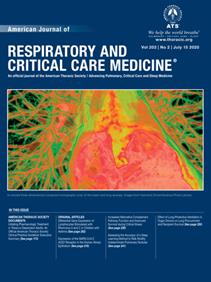On July 14th, 2020, the team of Professor Zuo Wei at Tongji University, School of Medicine published their new research article on the American Journal of Respiratory and Critical Care Medicine (AJRCCM, IF=17.452), the top-ranked journal in pulmonary and critical care medicine. This research, titled as "Single-cell RNA Expression profiling of ACE2, the receptor of SARS-CoV-2", reveals the distribution of receptor gene of SARS-CoV-2 in the lungs at single-cell resolution.

Cover of the current issue of the American Journal of Respiratory and Critical Care Medicine
As early as the outbreak of the COVID-19 epidemic in Wuhan, China, the Zuo group responded quickly and initiated a study on the distribution pattern of the SARS-CoV-2 receptor in the normal human lungs. This work is based on the public database and the state-of-the-art single-cell RNA-Seq technique. The RNA expression profile of angiotensin-converting enzyme 2 (ACE2), a proved SARS-CoV-2 receptor protein which is a prerequisite for viral entry, in every single cell of the human lung was analyzed closely. The results show that ACE2 is intensively expressed in a small population of type II alveolar epithelial cells (AT2) in the human lung. These virus-susceptible AT2 cells account for around 1% of the whole AT2 cell population. Zuo group also demonstrated that these AT2 cells not only express viral receptor ACE2, but also highly express many other genes that are closely related to viral entry, replication, and transmission, including the cell membrane lipid raft-related gene CAV2 and ITGB6. Enrichment of multiple ESCRT machinery gene members, which were related to virus budding and release, in ACE2-expressing AT2 were also observed. The above data showed that this small population of ACE2-expressing AT2 is particularly prone to SARS-CoV-2 infection, and they may serve as an entry target, and subsequently be “hijacked” by the virus to assist the virus transmission.
“The preliminary version of the current research was first released on the preprint server bioRxiv on January 26, 2020,” says Professor Zuo. “It has been cited more than 250 times within half a year. We are glad to see its fast release has been instructive and helpful for some other subsequent researches on the distribution of ACE2 in other target organs, as well as therapeutic approaches for the development of novel anti-viral drugs targeting ACE2.”
Professor Zuo is the corresponding author, and Zhao Yu, Zhao Zixian, and Dr.Wang Yujia in his group are co-first authors of this article. Tongji University, Stem Cell Preparation and Quality Inspection Platform of Stem Cell Transitional Medical Base in Shanghai East Hospital, Regend Therapeutics Co., Ltd., The First Affiliated Hospital of Guangzhou Medical University, and Ningxia Medical University have provided strong supports for this work. Professor Gang Pei shared his valuable thoughts and comments during the manuscript revision process. The authors also salute to medical workers who sacrificed their lives in fighting COVID-19 pandemic in the acknowledgment section.
